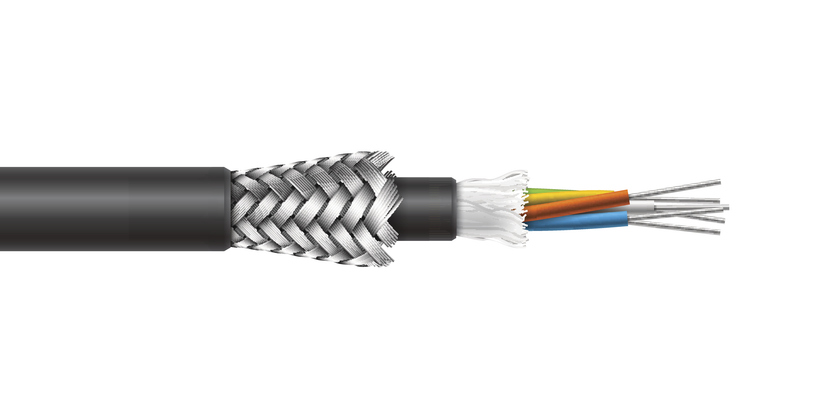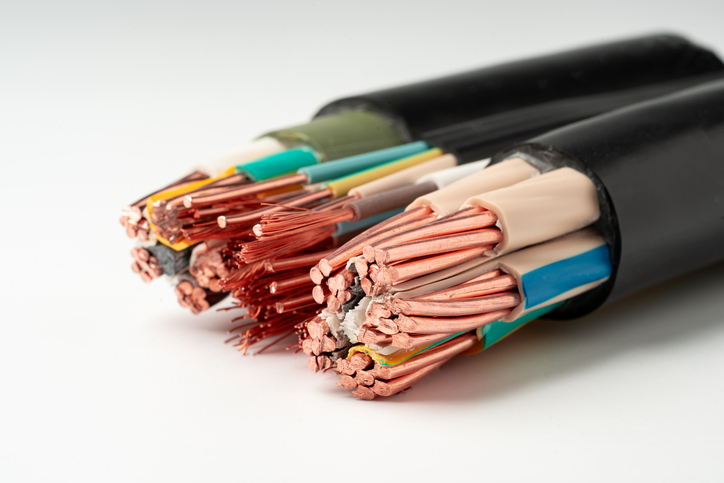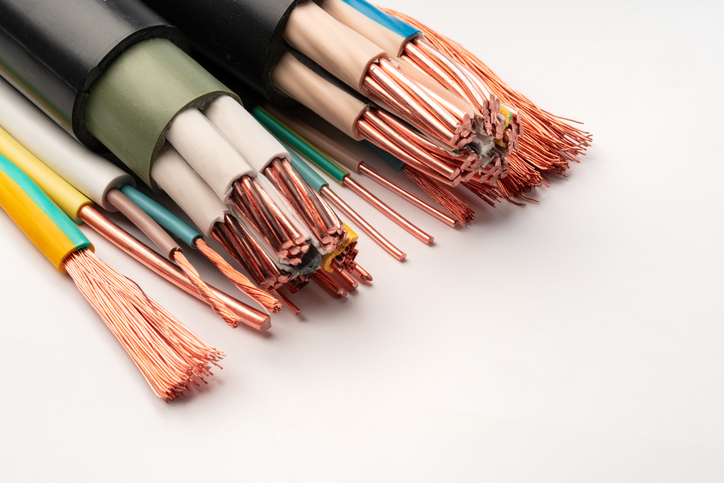Popular Wire & Cable Shielding Types
In situations with long signal runs or complex circuits, shielding becomes a crucial part of reducing interference and maintaining signal integrity. Metallic braids and foil shields are options for wire shielding that most people are likely familiar with. But there are additional options available that may fit your application better. We’ll explore the most common shielding types and their pros and cons.
Jump to a section:
- Metallic Braid Shields
- Foil Shields
- Spiral or Serve Shields
- Tape Shields
- Combination Shields
- Wire Shield Comparison Chart
Metallic Braid Shields
Metallic Braid Shields are usually formed from bare, tinned or silver plated copper strands. Steel and other metals can be used for physical protection. They are woven over a conductor or conductors in the same manner as a textile braid.
Braid shields effectiveness is proportional to the amount of braid coverage over the wire. 75-85% coverage is standard, 100% coverage is technically unobtainable. The greater the braid coverage, the slower it is to produce, the more it costs and the less it will flex. Braids provide mechanical strength as well as flexibility and flex life and are most effective at low frequencies.
Often a braid shield is supplemented by a foil shield to increase shield coverage and still provide the benefits of a braid shield and maximum shield coverage. Braid shields are specified on all mil spec applications.
To terminate a braid shield it is necessary to unbraid the braiding material and hand terminate to ground. An uninsulated ground wire can be included, in contact with the braid for easy termination. The normal drain wire in electronic applications is tinned copper to prevent the drain from corrosion. The braid can be "pig tailed" for termination.
Key factors to consider when using metallic braid shields include:
- Greater flex life and flexibility
- Increased mechanical strength
- Offers physical protection
- Effective at all frequencies
- Braids can be combined with foil for maximum performance
- 40% to 96% coverage
- Difficult to terminate
- Slow and costly to produce
- More costly than foil
Foil Shields
Foil Shields are usually constructed of an aluminum and mylar composite tape. The appearance is much like the foil in a gum wrapper. Foil shields are lightweight, inexpensive and easy to apply. Foil can face in or out. The drain wire must be in contact with the metallic part of the shield.
Foil shields will provide 100% shield coverage and are normally terminated (grounded) with a drain wire. The drain wire provides easy termination. Foil shields, especially in multi pair constructions can be color coded. Foil provides good flexibility but limited flex life.
One side of a foil shield is metallic and the opposite side is non-conductive. The drain wire must be in contact with the aluminum (metallic) side of the shield to provide for proper grounding of the shield. The drain wire is usually one size smaller than the conductors it is terminating the shield for. The shield can face in towards the conductors or face outward toward the jacket.
Key factors to consider when using foil shields include:
- Thin and lightweight
- Good flexibility, mediocre flex life
- Can reach 100% coverage
- Easy to produce
- Less costly than braids
- Easy to terminate
- Braids can be combined with foil for maximum performance
- No mechanical strength
- Little physical protection
- Requires a drain wire
Spiral or Serve Shields
Spiral or Serve Shields are usually formed from bare, tinned or silver plated copper strands. Steel and other metals can be used for physical protection. The main advantage to a spiral or serve shield is that they are more flexible than braid shields and provide for easy termination. These shields are constructed by wrapping the shield material in one direction around the conductors. A reverse spiral shield is formed by wrapping shielding material in both directions on separate layers with no interweaving of wires.
Although spiral or serve shields can obtain shield coverage of 95% and greater they are recommended only for audio applications due to the frequencies they shield against.
- Inexpensive to produce
- Good flexibility
- Easy to terminate
- Cannot reach full coverage (up to 95%)
- Can be delicate
- Limited frequency coverage - audio use only
Tape Shields
Tape Shields are formed from a variety of materials, most common are copper, aluminum and bronze. Tape shields are applied at cabling and are wrapped around the conductors that are being shielded. A drain wire is required for easy termination. Copper and aluminum are usually combined with a backing such as mylar or polyester, much like foil shields. Tape shields can reach 100% coverage. Properties are similar to foil shields.
- Thin and lightweight
- Good flexibility
- Can reach 100% coverage
- Easy to produce
- Less costly than braids
- Easy to terminate
- Braids can be combined with foil for maximum performance
- Mediocre flex life
- No mechanical strength
- Little physical protection
- Requires a drain wire
Combination Shields
Combination Shields are formed of two or more shields combined in the same cable. The most common combinations are a braid shield over a foil shield or a braid shield over a braid shield.
Key factors to consider when using combination shields include:
- Maximum shield effectiveness
- Good physical protection
- Easy to terminate
- 100% foil coverage
- Good flexibility
- Low DC resistance
- Good flex life
- Good mechanical strength
- Costly to produce
Wire Shield Comparison Chart
|
Type |
Description |
|
Metallic Braid Shields |
Made from bare, tinned, or silver-plated copper strands, metallic braid shields offer 40%-96% coverage, good mechanical strength, and flexibility. Effective at low frequencies, they are more costly and difficult to terminate compared to other shields. |
|
Foil Shields |
Constructed of aluminum and mylar composite tape, foil shields provide 100% coverage, are lightweight, and easy to produce. They offer good flexibility but limited flex life and require a drain wire for termination. Less costly than braid shields. |
|
Spiral / Serve Shields |
Formed from bare, tinned, or silver-plated copper strands wrapped in one direction, spiral shields offer up to 95% coverage, are highly flexible, and easy to terminate. Best for audio applications due to limited frequency coverage. Inexpensive to produce. |
|
Tape Shields |
Made from copper, aluminum, or bronze tapes, tape shields offer similar properties to foil shields with 100% coverage, good flexibility, and easy termination. They require a drain wire and provide mediocre flex life and little mechanical strength. |
|
Combination Shields |
Combination shields integrate two or more shielding types, typically a braid over foil, to maximize effectiveness. They offer 100% coverage, good physical protection, and flexibility. Although they provide excellent mechanical strength and low DC resistance, they are more costly to produce. |
Related Resources

Shielding
Shielding is a vital aspect of cable design , providing a protective barrier that confines electrical energy within the cable. This shielding prevents signal leakage, which could lead to interference with nearby cables or sensitive electronics. It also safeguards the cable's signal from external sources of electromagnetic interference (EMI), ensuring the data remains intact and reliable.Learn More
Armor
Two of the most common armor types are Interlocked Armor and Continuously Welded Corrugated Armor.Learn More
What is a Cable?
Cable, or cabling, consists of the twisting together of two or more insulated conductors.Learn More


